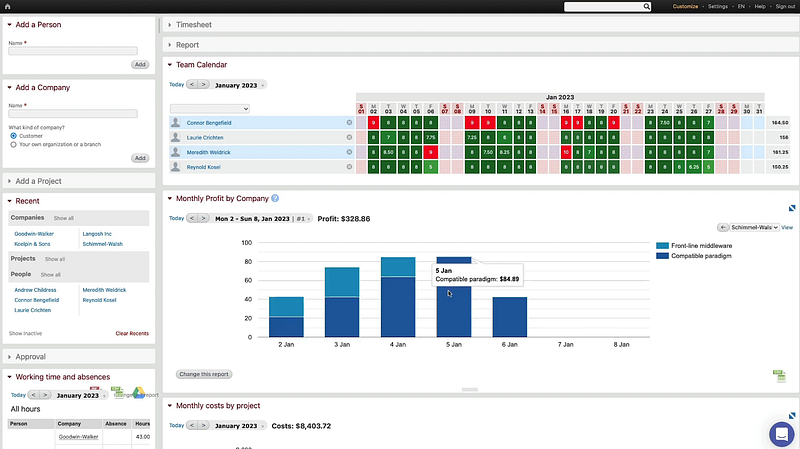Do you struggle to keep up with your billable hours or are unsure how much to charge clients? Accurate billing is essential for financial success as a freelancer or business owner. Fortunately, timesheets for billing can simplify the process and provide an indisputable record of the time spent on each project.
This article will lead you through the critical steps of using timesheets for billing purposes. We’ll discuss understanding timesheets, setting up your system, tips and tricks for effective tracking and accurate invoicing, and best practices in timesheet management.
Plus, we’ll suggest top-rated timesheet software to make your billing process smoother. So, whether you’re new to timesheets or looking to refine your existing system, read on for how-tos on streamlining your billing and boosting profits.
You may use one of the following links to navigate to the corresponding section directly:
- Understanding Timesheets for Billing
- How to Use a Timesheet for Billing?
- Setting Up Your Timesheet System
- Best Practices for Timesheet Management
- Strategies for Accurate Billing
- Best Timesheet Software for Billing Project
- Wrap-up: Use Day.io to Convert Minutes for Timesheet Billing with Ease

Understanding Timesheets for Billing
A timesheet is a document that records the time spent on tasks, projects, or any other activity. Timesheets are essential for tracking client billable hours and ensuring your invoices accurately reflect the work done.
Tracking with a timesheet means you’re less likely to miss out on claiming every hour worked and helps protect against underbilling or overbilling mistakes. It’s also an invaluable tool for monitoring project timelines and budgeting for future projects.
Using timesheets can be especially beneficial if you need to track multiple employees’ working hours, such as in a larger company setting. You can use timesheets to monitor the project’s progress, allocate resources accordingly, and ensure everyone works efficiently.
Benefits of using timesheets for billing include:
- Accurate tracking of hours worked
- Easy monitoring of project timelines and resources
- Efficient invoicing that reflects the work done
- Protection against underbilling or overbilling mistakes
How to Use a Timesheet for Billing?
Let’s go through a step-by-step tutorial on how to use a timesheet for billing.
- Step 1: List the tasks or activities you need to track on your timesheet. Ensure each task is specific and clear so there’s no room for confusion when it comes time to invoice your clients.
- Step 2: Record each activity’s start and end times in the appropriate columns on your timesheet. If you want to get more precise with tracking minutes, check out Day.io – an online tool that converts minutes into hours and vice versa quickly and accurately!
- Step 3: Once all tasks are logged, calculate the total hours worked on each project. This can be done manually or with a timesheet software that automates the task for you.
- Step 4: Add up all hours worked and create an invoice based on your billing rate. Ensure you include any expenses related to the project, such as materials used or travel costs incurred. Once done, you will need to convert minutes for timesheet billing. You will find various timesheet software for the purpose.
- Step 5: Send the invoice to your client and wait for payment!
5 Steps In Setting Up Your Timesheet System
Now that we’ve covered the basic steps for using a timesheet for billing let’s explore how to set up an efficient timesheet system.
1. Assess Your Needs
Before setting up a timesheet system, assessing your needs is important. Are you tracking hours for just yourself or multiple employees? Do you need to track expenses as well? Answering these questions will help you determine what type of timesheet system best suits your requirements. For instance, a timesheet for billing accounting professional hours can do it effortlessly for independent accountants.
2. Choose the Right Software
If you plan on tracking more than one employee, then having a software solution is essential. Many timesheet programs on the market offer features such as automated invoicing and expense tracking, allowing for easier management and accuracy when it comes time to bill clients.
3. Train Your Employees
Once you have chosen your timesheet software, ensure all employees know how to use it properly. Provide detailed instructions and practice sessions so everyone is comfortable with the system.

4. Set Clear Policies
Establishing clear policies and procedures around timesheets will ensure everyone is on the same page. Ensure all employees know when to submit their timesheets, what information needs to be included, and how long they have to do it.
5. Monitor Timesheets
Regularly monitoring timesheets will help ensure accuracy and protect against mistakes. Make sure all time entries are accurate, review any discrepancies and check for any incorrect billing information.
Best Practices for Timesheet Management
To get the most out of your timesheet system, you should keep a few things in mind. Here are some tips for effective results with your timesheet:
- Make sure everyone involved understands how to use the timesheet properly and consistently record their hours worked.
- Ensure all employees record their time as soon as they finish working on something so that no billable hour is missed.
- Be aware of any idle time or overtime, and include these hours in billing accordingly.
- Set up notifications for when someone’s about to go over budget or project timeline.
- Provide regular feedback to employees on how they’re doing with their timesheets.
- Regularly review your timesheet system and adjust as needed for better performance.
Strategies for Accurate Billing
Accurate billing is essential for ensuring you get paid correctly and on time. Here are some strategies to help ensure precise timesheet billing:
- Set up specific billing categories and set rates for each category. This will help you easily track the time spent on different tasks or projects and ensure you charge correctly based on those rates.
- Establish a timesheet approval process to ensure accuracy before it is submitted for billing purposes. Have a supervisor or manager review all timesheets before invoicing them to your customers or clients. This will reduce errors in the billing process and ensure everyone is being billed accurately for their time worked.
- Establish clear expectations with clients about what type of work they are charged for. This will help eliminate confusion or misunderstandings about what services are being billed and how much they should be set.
- Make sure that all timesheets are submitted in a timely manner so that invoices can be sent out as soon as possible. This will ensure you get paid quickly and reduce the chances of late or no payments.
3 Best Timesheet Software for Billing Projects
Timesheet software is a great way to keep track of time spent on projects and ensure accurate billing. Here are some of the best timesheet software for billing projects:
1. Day.io – Overall, the Best Timesheet Software for Billing

Day.io is a cloud-based timesheet and billing software for small businesses. It helps small business owners to track time, manage projects, bill clients, and create invoices in one centralized platform. This software includes features like project management, task tracking, client onboarding/management, invoicing/billing automation, document storage, and collaboration tools.
Day.io also has an easy-to-use dashboard that lets users quickly view progress on current tasks or projects while providing detailed information about the work (such as hourly rate versus total hours billed). The dashboard can be customized according to the user’s preferences.
Features
- Timesheets and project tracking
- Project reports with detailed task breakdowns
- Cost and billing information with future forecasting and resource planning
- Time tracking with automatic and manual approval management
- Overtime pay and controllable extra hours billing
- Digital signature authentication and cloud storage
- Collaboration and team messaging
Pricing
- Project time tracking: $6 per user/month
- Time & attendance tracking: $4 per user/month
2. Scoro – Timesheet and Billing Automation with Visual Templates

Scoro is an all-in-one business management solution that helps teams stay organized and manage their projects. It comes with a powerful timesheet and billing system, which automates tracking time spent on tasks and invoicing clients.
The Scoro dashboard lets users visually track progress in real time while providing detailed information (such as hours billed versus total hours worked). The software also includes templates for creating professional invoices quickly and easily.
Features
- Project management and task tracking
- Timesheet automation
- Detailed reporting on projects, teams, and clients
- Integration with third-party apps (e.g., Slack, Zoom)
- Real-time visibility of invoices due/paid/pending approval
Pricing
- Essential: $28 per user/month
- Standard: $42 per user/month
3. BeeBole – Easy and Intuitive Timesheet and Invoicing Tool

BeeBole is a robust timesheet and invoicing tool that helps teams track work hours, create invoices, and manage client relationships. The software includes project tracking, task management, customer onboarding/management tools, activity reporting, and analytics.
Features
- Time tracking and expenses management
- Projects, tasks, and to-dos tracking
- Team scheduling with resource planning
- Invoice creation (both recurring and one-time)
- Statistics & progress reports for timesheets, projects, customers & teams
Pricing
€6.99 per user/month

Wrap-up: Use Day.io to Convert Minutes for Timesheet Billing with Ease
Using a timesheet for billing purposes can be a great way to ensure accurate and timely invoicing. By setting up a specific timesheet system with categories and rates, you can easily track the time spent on different tasks or projects and ensure you bill your clients accurately.
For accurate timesheet management, Day.io is the best software to use for billing projects as it offers easy conversion from minutes to hours so that invoices can be sent out quickly and efficiently. Try Day.io today and start streamlining your timesheet management!


